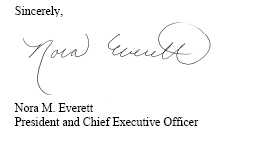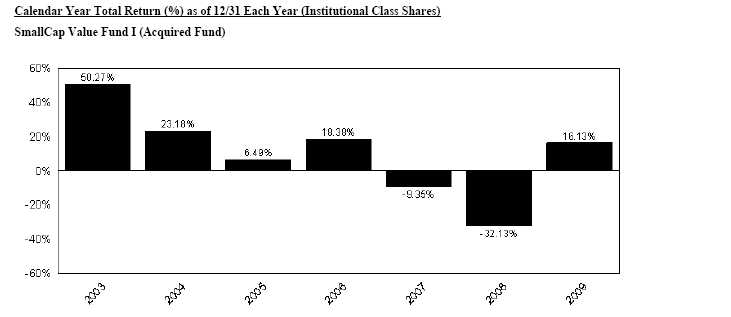| |
| PMC | Thomas D. Stevens (since 2009). Mr. Stevens (Chairman and |
| | President) co-founded L.A. Capital in 2002. He earned a BBA and |
| Mariateresa Monaco (since 2009). Ms. Monaco (Vice President- | MBA from the University of Wisconsin. Mr. Stevens has earned |
| Portfolio Manager) has worked as a portfolio manager for PMC | the right to use the Chartered Financial Analyst designation. |
| since 2009. Previously, she worked as a portfolio manager for | |
| Principal Global Investors, LLC, where she worked as a portfolio | VAUGHAN NELSON |
| manager since 2005. Prior to that, Ms. Monaco worked for | |
| Fidelity Management and Research. She earned a Master’s degree | Chris D. Wallis (since 2005). Mr. Wallis (Senior Portfolio |
| in Electrical Engineering from Politecnico di Torino, Italy, a | Manager) has been with Vaughan Nelson since 1999. He earned a |
| Master’s degree in Electrical Engineering from Northeastern | BBA in Accounting from Baylor University and an MBA from |
| University, and an MBA from the Sloan School of Management at | Harvard Business School. Mr. Wallis has earned the right to use |
| the Massachusetts Institute of Technology. | the Chartered Financial Analyst designation. |
| | Scott J. Weber (since 2005). Mr. Weber (Portfolio Manager) has |
| | been with Vaughan Nelson since 2003. He earned a BS in Natural |
| | Resources from The University of the South and an MBA from |
| | Tulane University. Mr. Weber has earned the right to use the |
| | Chartered Financial Analyst designation. |
| |
| | PMC |
| |
| | Mariateresa Monaco (see biography under Acquired Fund) |
| |
| Comparison of Investment Objectives and Strategies |
| Investment Objective: | |
| Both Funds seek to provide long-term growth of capital. |
| Principal Investment Strategies: | |
| The Fund invests primarily in a diversified group of equity | Under normal circumstances, the Fund invests at least 80% of its |
| securities of U.S. companies with small market capitalizations | net assets (plus any borrowings for investment purposes) in equity |
| (those with market capitalizations similar to companies in the | securities of U.S. companies with small market capitalizations |
| Russell 2000® Value Index (as of the most recent calendar year | (those with market capitalizations similar to companies in the |
| end, this range was between approximately $0.01 billion and $3.4 | Russell 2000 Value Index (as of the most recent calendar year end, |
| billion)) at the time of purchase. Market capitalization is defined | this range was between approximately $0.01 billion and $3.4 |
| as total current market value of a company's outstanding common | billion)) or in securities with market capitalizations of $3.5 billion |
| stock. Under normal conditions, the Fund invests at least 80% of | or less at the time of purchase. Market capitalization is defined as |
| its net assets in equity securities of such companies. The Fund | total current market value of a company's outstanding common |
| invests in value stocks; value orientation emphasizes buying | stock. The Fund invests in value stocks; value orientation |
| stocks at less than their expected investment value and avoiding | emphasizes buying stocks at less than their expected investment |
| stocks whose price has been artificially built up. The Fund’s assets | value and avoiding stocks whose price has been artificially built |
| may be invested in foreign securities. The Fund may invest in real | up. This Fund may be used as part of a fund of funds strategy. |
| estate investment trusts in an attempt to achieve its investment | |
| objective. The Fund may also purchase securities issued as part of, | Dimensional invests Fund assets primarily in a diversified group |
| or a short period after, companies’ initial public offerings | of equity securities of small cap U.S. companies which |
| (“IPOs”), and may at times dispose of those shares shortly after | Dimensional believes to be value stocks at the time of purchase. |
| their acquisition. This Fund may be used as part of a fund of funds | Dimensional considers small cap companies to be companies |
| strategy. | whose market capitalizations are generally in the lowest 10% of |
| | total market capitalization or companies whose market |
| J.P. Morgan uses a combination of quantitative and fundamental | capitalizations are smaller than the 1,000th largest U.S. company, |
| research, and then implements a disciplined portfolio construction | whichever results in the higher market capitalization break. Under |
| process to build a portfolio. It seeks to enhance returns and reduce | Dimensional’s market capitalization guidelines described above, |
| the volatility in the value of the Fund relative to that of the U.S. | as of December 31, 2009, the market capitalization of a small cap |
| small company value universe, represented by the Russell 2000® | company was defined by the 10% market capitalization guideline, |
| Value Index. J.P. Morgan continuously screens the small company | which was $2,210 million or below. This dollar amount will |
| universe to identify those companies that exhibit favorable | change due to market conditions. |
| valuation and momentum factor rankings. J.P. Morgan ranks these | |
| companies within economic sectors according to their relative | Dimensional considers a security to be a value stock primarily |
| attractiveness. J.P. Morgan then selects for purchase the | because the company’s shares have a high book value in relation |
| companies it feels to be most attractive within each economic | to their market value (a “book to market ratio”). In assessing |
| sector. | value, Dimensional may consider additional factors such as price |
| | to cash flow or price-to-earnings ratios, as well as economic |
| Under normal market conditions, the portion of the Fund sub- | conditions and developments in the issuer’s industry. The criteria |
| advised by J.P. Morgan will have sector weightings comparable to | Dimensional uses for assessing value are subject to change from |
| that of the U.S. small company value universe though it may under | time-to-time. |
| or over-weight selected economic sectors. In addition, as a | |
| company moves out of the market capitalization range of the small | Dimensional uses a market capitalization weighted approach in |
| company universe, it generally becomes a candidate for sale. | determining individual security weights. The higher the relative |


